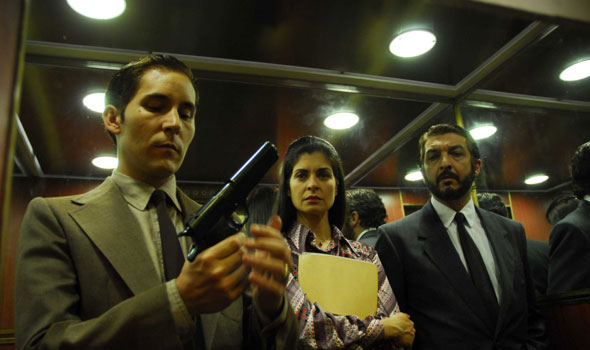Foreign Fare: The Lingering State of International Cinema
The state of foreign cinema in the United States has always been a troubled one. With Hollywood acting as an overwhelming force both stateside and overseas, it seems like a constant struggle for foreign films to get their due audience. Between a lack of support from the studio system and a general populace that believes reading should be saved for books, magazines, and iPads, foreign films have never been immersed in American culture.
Years pass with meaningless blockbusters and supposedly celebrated independent films that never quite hit their mark, and all the while there are handfuls of foreign films that go unnoticed or worse, unseen, simply because America’s film industry has yet to find a way to properly introduce world cinema to this country’s audiences.
Such was the case in 2009, a banner year both for Hollywood and international cinema. With “Avatar” grossing over $2 billion worldwide and “Transformers 2” grossing a little less than half of that, Hollywood was on top, proving once again why the system “works”.
But while audiences worldwide were being dazzled by Hollywood’s 3-D presentations of 2-D characters and their showmanship of lackluster scripts filled with blatant plot rip offs and cheese-laden dialogue, a different kind of cinema was blossoming; one that did not require special glasses or a billion dollar overhaul to make it feel important.
Instead, these films were ones that relied on roundly woven characters, insightful glimpses into worlds often ignored by the general population, and screenplays that defied convention.
And, surprisingly enough, not a single one was in the English language.
Foreign films left in the shadows
It should also be noted that this year, 2009, was the year the Academy of Motion Pictures Arts & Sciences, the group behind the Academy Awards, decided to amend a more than sixty-year old rule of limiting nominations for the Best Picture category to five films, and expanding it to ten.
With the Academy Awards serving as a launching pad for films, actors, and directors, this decision to include five more films into the most prestigious category of them all seemed a sure fire way to spotlight acclaimed films that maybe needed that extra push into the public’s consciousness.
But unfortunately, the Academy saw this as a way to include more meaningless, Hollywoodized tales such as “The Blind Side” and “Up”, both films most likely being nominated because of their box office receipts and not the content of the picture.
And while studios were busy lifting their receipts high in the air for all to see, three films, all of which were included in the Best Foreign Film category for the year, were going largely ignored by the public simply because they were unaware the films existed.
1. The White Ribbon

Cannes Film Festival Palme d’Or winner "The White Ribbon”
The first, “The White Ribbon”, won the Palme d’Or at the Cannes Film Festival, a prestigious prize that should inherently guarantee a film at least one-thousand good marketplaces, but instead serves as almost a stigma for American audiences to stay away.
The film follows a small German town in the years leading up to, but not dealing directly with, World War I. When strange events begin to occur to the townsfolk, and sometimes their pets, it seems the village’s suppressed school children are at the core of the mystery.
Directed by Michael Haneke, creator of the insanely scarring and yet utterly fascinating “Funny Games”, “The White Ribbon” was shot in black and white and, like most foreign films anyway, featured a largely unknown cast.
The film is unique in its revealing and often disturbing character development, and though methodically paced in unraveling what exactly is happening in this small village, it is an endlessly enticing and emotionally rich story that flourishes under the steady direction of Haneke.
2. A Prophet

Un Prophete
The second film, “A Prophet”, directed by Jacques Audiard, follows the extreme misadventures of a young Arab Malik, who is sentenced to a French prison where he “befriends” the Corsican mafia and their head honcho Cesar, who runs the cement hellhole.
Over the years Malik sinks deeper and deeper into the criminally active life of a prison inmate and, over time, plots his ascension to the top of the prison hierarchy.
A dark, often brutally violent film, “A Prophet” soars from its authentic representation and insight into the life of prison inmates as well as the cultural differences, bias and struggles people must face, whether incarcerated or not.
3. The Secret in Their Eyes

The Secret in Their Eyes
The third film, which eventually took home the prize from the fabled Academy Awards, is Juan Jose Campanella’s sublimely beautiful “The Secret in Their Eyes”. The film revolves around legal counselor Benjamin Esposito as he and his partner attempt to discover the truth behind the senseless rape and subsequent murder of a beautiful young woman.
The case haunts Esposito as he discovers the awful truth behind the murder and at the same time, the limitations of both the government he has sworn to serve and the man he has claimed to become.
Guided by what is sure to become a revered screenplay, “The Secret in Their Eyes” is a nearly perfect film, from the supreme talent of its cast, to the unbelievably evocative cinematography, this is a film that will truly stand the test of time; a film so good, Hollywood has already commissioned a remake.
Is Hollywood bias?
All three films, none of which grossed even $7 million in the United States, stood as the apex of film-making for not only the year, but served as an unfortunate reminder of the cultural bias still present in an art form as supposedly free and unlimited as film.
Had any or all three of these films landed an audience half as varied and widespread as “Avatar” or “Transformers”, than the film-making world would be experiencing a renaissance unheard of since the early nineties and the emergence of independent cinema as a legitimate and potentially profitable art-form.
This is not to say that foreign films are better than American films, or vice-versa. Anyone can make a bad movie just like anyone can make a good film. Every filmmaker or artist for that matter has a right to tell a story and express ideals, values and characters in any manner in which they choose. That is their inherent prerogative not only as artists but also as human beings.
However, when recognition and audience awareness is guided solely by money and the high cost of advertising and not the quality of work, one has to begin to question the system that is in place and wonder if films like these, of which there is surely going to be more on both sides, will ever strike a natural balance between engaging, thought provoking art, and fun, mindless popcorn attractions.
And when you face it, there is a need, and room, for both.
